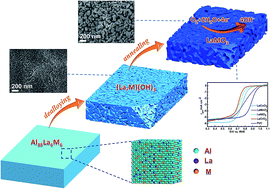Transforming bulk alloys into nanoporous lanthanum-based perovskite oxides with high specific surface areas and enhanced electrocatalytic activities†
Abstract
The limited surface area of a perovskite oxide obtained through a conventional synthesis route has often limited its catalytic performance. Creating nanoporous perovskite oxides with abundant amounts of mesopores is one of the key challenges to realize perovskite potential for energy conversion and storage applications. Here, we report a novel, facile synthesis route that exploits the de-alloying process to transform bulk alloys into nanoporous lanthanum (La)-based perovskite oxides. The synthesized La-based perovskites display ultrahigh specific surface areas in the range of 8.10–20.13 m2 g−1 and a unique ligament-like porous framework. Our systematic ORR and OER tests revealed their high electrocatalytic activity and durability in an alkaline solution, which are consistent with the density functional theory (DFT) calculations. The synthesis route reported here opens up a new avenue to create a new generation of functional perovskite oxides that are applicable to other catalytic and electrochemical applications.



 Please wait while we load your content...
Please wait while we load your content...